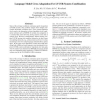66 search results - page 12 / 14 » A flat direct model for speech recognition |
ICPR
2006
IEEE
14 years 9 months ago
2006
IEEE
Coarticulation is one of the important factors that makes automatic sign language recognition a hard problem. Unlike in speech recognition, coarticulation effects in sign language...
INTERSPEECH
2010
13 years 2 months ago
2010
State-of-the-art large vocabulary continuous speech recognition (LVCSR) systems often combine outputs from multiple subsystems developed at different sites. Cross system adaptatio...
ICASSP
2011
IEEE
12 years 11 months ago
2011
IEEE
This paper introduces a method to train an error-corrective model for Automatic Speech Recognition (ASR) without using audio data. In existing techniques, it is assumed that sufï¬...
ICANN
2007
Springer
14 years 2 months ago
2007
Springer
Abstract. Recurrent neural networks (RNNs) have proved effective at one dimensional sequence learning tasks, such as speech and online handwriting recognition. Some of the properti...
PAMI
2008
13 years 7 months ago
2008
Little attention has been paid so far to physiological signals for emotion recognition compared to audiovisual emotion channels such as facial expression or speech. This paper inve...

